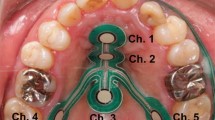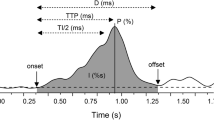Abstract.
Background and Aim:
Tongue dysfunctions are of etiologic significance for the development of malocclusions and speech disorders. Electromagnetic articulography is a means of recording orofacial movements. The aim of this study was therefore to analyze differences in the spatial and temporal sequence of swallowing movements under the influence of lip and tongue dysfunctions in order to develop new means of objectifying the diagnosis of such a dysfunction.
Patients and Method:
Thirty-one subjects were monitored during reflex swallowing and while swallowing 20 ml of water. All probands also underwent evaluation by a speech pathologist as well as palatography. The entire cohort was then divided into a viscerally and a somatically swallowing group, and the movement sequences were analyzed with reference to spatial and temporal parameters.
Results:
The temporal parameters revealed fewer significant differences than the spatial parameters. Most differences were recorded for the section between palate separation point and end of swallowing. Specific spatial or temporal variables revealing a maximum number of differences between the two groups were found for each tongue region. Swallowing water revealed notably more significant intergroup differences. The most suitable variables during the swallowing of water were the maximum distance of tongue-palate contact and the distance or time interval between palate separation point and end of swallowing.
Conclusion:
The analysis of swallowing movements by electromagnetic articulography offers opportunities to evaluate tongue dysfunctions. The most suitable combination of variables was found for each of the regions investigated. Spatial analysis of the movement pattern seems to be the most reliable method.
Zusammenfassung.
Hintergrund und Ziel:
Orofaziale Fehlfunktionen sind für die Entstehung von Kieferanomalien und Artikulationsstörungen von Bedeutung. Eine Möglichkeit zur Erfassung orofazialer Bewegungen bietet die elektromagnetische Artikulographie. Ziel der Studie war daher, Unterschiede im räumlichen und zeitlichen Ablauf von Schluckbewegungen unter dem Einfluss einer Lippen- und Zungenfehlfunktion zu untersuchen, um neue Möglichkeiten zur Objektivierung der Diagnostik einer derartigen Funktionsstörung zu entwickeln.
Patienten und Methode:
Untersucht wurden 31 Probanden beim Leerschlucken bzw. 20 ml Wasserschlucken. Zusätzlich wurden ein logopädischer Status sowie eine Palatographie erstellt. Das Gesamtkollektiv wurde in eine viszeral und eine somatisch schluckende Gruppe unterteilt und die Bewegungsbahnen mittels geometrischer und zeitlicher Parameter analysiert.
Ergebnisse:
Im Vergleich zu den geometrischen Variablen wurden weniger signifikante Unterschiede bei den Zeitvariablen gefunden. Der Abschnitt zwischen dem Gaumenablösepunkt und dem Schluckende wies dabei die meisten Unterschiede auf. Für jede Zungenregion konnten spezifische Strecken- oder Zeitvariablen gefunden werden, welche eine maximale Anzahl Unterschiede zwischen beiden Gruppen aufwiesen. Das Wasserschlucken wies deutlich mehr signifikante Unterschiede zwischen den Gruppen auf. Besonders geeignet waren beim Wasserschlucken die maximale Distanz Gaumenkontakt sowie die Strecke bzw. der Zeitabschnitt zwischen Gaumenablösepunkt und dem Schluckende.
Schlussfolgerung:
Die Analyse von Schluckbewegungen mit Hilfe der elektromagnetischen Artikulographie bietet die Möglichkeiten der Evaluation einer Zungenfehlfunktion. Abhängig von der zu untersuchenden Region konnten dafür die geeignetsten Schlucksequenzen gefunden werden. Die räumliche Analyse des Bewegungsablaufes scheint hierfür die zuverlässigste Methode zu sein.
Similar content being viewed by others
Author information
Authors and Affiliations
Corresponding author
Rights and permissions
About this article
Cite this article
Horn, H., Kühnast, K., Axmann-Krcmar, D. et al. Influence of Orofacial Dysfunctions on Spatial and Temporal Dimensions of Swallowing Movements. J Orofac Orthop 65, 376–388 (2004). https://doi.org/10.1007/s00056-004-0315-1
Received:
Accepted:
Issue Date:
DOI: https://doi.org/10.1007/s00056-004-0315-1




